List of Mil Mi-24 variants
The Soviet and later Russian Mil Mi-24 helicopter has been produced in many variants, as described below.
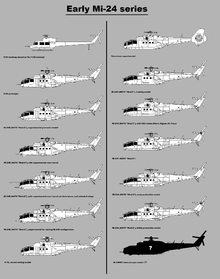
History
In 1966, Soviet aircraft designer Mikhail Mil created a mock-up design of a new helicopter (derived from the Mil Mi-8) which was made with the intent of fulfilling both the role of a close air support aircraft as well as being able to transport infantry into combat.[1] This prototype design was designated the V-24, and in 1968 a directive was given to proceed with the development of the helicopter.
The Mi-24 went from the drawing board to the first test-flights in less than eighteen months, with the first models being delivered to the Soviet Armed Forces for evaluation in 1971. As a result of the speedy development, the initial Mi-24 variants had a number of problems: lateral roll, weapon sighting issues, and a limited field of view for the pilot. A later redesign of the Mi-24's front section solved most of these problems.[2]
List of variants
- A-10
- Designation given to the aircraft used for record breaking from 1975 in the FAI E1 class.[3]
- V-24
- The first version, twelve prototypes and development aircraft. The first V-24 mockup resembled the Bell UH-1A Huey. Later models resembled the future Hind-A, one of which was modified in 1975 as A-10 for speed record attempts with wings removed and faired over and with inertia-type dampers on the main rotor head. The A-10 reached a speed of 368 km/h. It was armed with the GSh-23 autocannon and could carry up to six missiles or rockets.
- Mi-24
- (Hind-A) An early version of the Mi-24, which could carry eight combat troops and three crew members. It could also carry four 57mm rocket pods on four underwing pylons, four MCLOS 9M17 Fleyta (AT-2 Swatter) anti-tank missiles on two underwing rails, free-fall bombs, plus one Afanasev A-12.7 12.7mm machine-gun in the nose. The Mi-24A was the first production model.
- Mi-24B
- (Hind-A) Experimental variant of the Hind-A, one of which was used to test the Fenestron tail rotor.
- Mi-24F
- (Hind-A) Modified Hind-A with seven reinforcing ribs on the port fuselage aft of the wing and the SRO-2M Khrom ("Odd Rods") IFF antenna relocated from the canopy to the oil cooler. The APU exhaust was also extended and angled downwards. The designation may be unofficial.
- Mi-24A
- (Hind-B) The Mi-24A was the second production model. Both the Mi-24 and Mi-24A entered into Soviet Air Forces service in 1972. It lacked the four-barrel Yak-B 12.7mm machine gun under the nose.
- Mi-24U
- (Hind-C) Training version without nose gun and wingtip stations.
- Mi-24BMT
- Small number of Mi-24s converted into minesweepers.
- Mi-24D (Hind-D)
- The Mi-24D was designed to be a more pure gunship than the earlier variants. It entered production in 1973. The Mi-24D has a redesigned forward fuselage, with two separate cockpits for the pilot and gunner. It is armed with a single 12.7mm four-barrel Yak-B machine-gun under the nose. It can also carry four 57mm rocket pods, four SACLOS 9M17 Phalanga anti-tank missiles (a significant enhancement compared to the MCLOS system found on the Mi-24A), plus bombs and other weapons. One Mi-24D was sold to Poland in January 1996 and was used by the WTD 61 in Manching during 1994 for tests with the head of a MIM-23 Hawk missile in place of the chin-mounted gun. This version also had an unidentified modification in the rear cabin window on the starboard side.
- Mi-24PTRK
- Modification of the Mi-24D that was used for testing the Shturm V missile system for the Mi-24V.
- Mi-24DU
- A small number of Mi-24Ds were built as training helicopters with doubled controls.
- Mi-24V
- (Hind-E) Later development which entered production in 1976. It was armed with the more advanced 9M114 Shturm (AT-6 Spiral). Eight of these missiles are mounted on four outer wing pylons. It was the most widely produced version with more than 1,500 made. In Polish service this aircraft is designated Mi-24W. One Mi-24V was referred to as Mi-24T for unknown reasons.
- Arsenal Mi-24V upgrade
- Ukrainian upgrade for Mi-24V.
- Mi-24P
- (Hind-F) The gunship version, which replaced the 12.7mm machine-gun with a fixed side-mounted 30mm GSh-30-2K twin-barrel autocannon.
- Mi-24TECh-24
- Experimental Mi-24P to test abilities for recovery of downed aircraft.
- Mi-24VP
- (Hind-E Mod) Development of Mi-24V made in 1985 which replaced the machine-gun with twin 23mm autocannons in a movable turret. Entered service in 1989, but only 25 were made before production ended the same year.[4] One Mi-24VP flew with the Delta-H tail rotor of the Mil Mi-28.
- Mi-24VU
- (Hind-E) Indian training version of Mi-24V.
- Mi-24VD
- A version produced in 1985 to test a rear defensive gun.
- Mi-24RKhR
- (Hind-G1) NBC reconnaissance model, which is designed to collect radiation, biological and chemical samples. It was first seen during the 1986 Chernobyl disaster. Also known as the Mi-24R, Mi-24RK and Mi-24RKh (Rch).
- Mi-24RA
- (Hind-G1 Mod) New version of the Mi-24V.
- Mi-24RR
- Radiation reconnaissance model derived from the Mi-24R.
- Mi-24K
- (Hind-G2) Army reconnaissance, artillery observation helicopter.
- Mi-24M
- Proposed naval version, unbuilt.
- Mi-24VM
- Upgraded Mi-24V with updated avionics to improve night-time operation, new communications gear, shorter and lighter wings, and updated weapon systems to include support for the 9M120 Ataka, Shturm and 9K38 Igla ATGM missiles and a 23mm main gun. Other internal changes have been made to increase the aircraft life-cycle and ease maintenance.
- Mi-24VN
- (Hind-E) A night-attack version based on an Mi-24V in Mi-24VM Stage 1 configuration.
- Mi-24PM
- Upgraded Mi-24P using same technologies as in Mi-24VM. Currently delivered to the RuAF.[5]
- Mi-24PN
- A version of the Mi-24P with a TV and a FLIR camera located in a dome on the front of the aircraft, and is armed with the GSh-23L. The Russian Air Force received 14 Mi-24PNs in 2004.[6]
- Mi-24PS
- Civil police or paramilitary version, equipped with a FLIR, searchlight, loudspeaker PA system and attachments for rappelling ropes.
- Mi-24V Ecological Survey Version
- Environmental research modification developed by the Polyot Industrial Research Organisation.
- Mi-24 SuperHind Mk.II
- Modern western avionics upgrade produced by South African company Advanced Technologies and Engineering (ATE).[7] Prototypes converted from Mi-24R models, and one Mi-24P was used to test sighting system.
- Mi-24 SuperHind Mk.III
- Extensive operational upgrade of the original Mi-24 including weapons, avionics and counter measures.[8]
- Mi-24 SuperHind Mk.IV
- Upgraded Mk. III version with Pall vortex engine air particle separator system over the engine intakes.
- Mi-24 SuperHind Mk.V
- Newest version of the "SuperHind" with fully redesigned front fuselage and cockpit. Mock-up only.
- Mi-24 Afghanistan field modifications
- Passenger compartment armour and exhaust suppressors were often removed. Extra rounds for the rocket pods to allow self-reloading near the battlefield and also heavy weapons for self-defense were often carried.[9]
- Tamam Mi-24 HMOSP
- Israeli upgrade.
- Mi-24P-1M
- Latest modernization of Mi-24P helicopters, fitted with a new modular direct infrared countermeasures system, autopilot, improved power supply unit and OPS-24N-1L navigation and targeting station. It has also an option for an active electronically scanned array (AESA) radar. First unveiled at 2019 MAKS International Aviation and Space Salon.[10]
- Mi-25
- The export version of the Mi-24D.
.jpg)
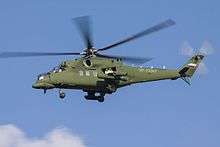
- Mi-35
- (Monsoon) The export version of the Mi-24V.
- Mi-35M
- Night attack version fitted with upgraded advanced avionics and sensor package, including night vision systems, GOES-342 electro-optical range finder/targeting system, GLONASS/GPS navigation system, electronic multifunction displays, onboard computer, and jam-proof communications equipment.[11] Also known as Mi-35M1. More than 60 are in service with the Russian Air Force and it has also been exported.[12] By September 2018, all Russian Air Force's Mi-35Ms were equipped with Vitebsk onboard defense system.[13]
- Mi-35MS
- Flying Command Post variant of the Mi-35M. Operated by the Russian Federal Protective Service (FSO).[14]
- Mi-35M2
- Updated version of the Mi-35M for the Venezuelan Army.
- Mi-35M3
- Export variant of the Mi-24VM.
- Mi-35M4
- (AH-2 Sabre) Updated version of the Mi-35M with Israeli avionics for the Brazilian Air Force.
- Mi-35P
- The export version of the Mi-24P.
- Mi-35P
- Russian Helicopters holding has developed a common standard for Mi-24 modernization designated as Mi-35P. The Mi-35P has received the OPS-24N-1L observation-sight system with a third generation long-wave matrix thermal imager, TV camera, and laser rangefinder. The upgraded gunship’s cockpit has the KNEI-24E-1 flight navigation system with multifunctional displays. The PKV-8-35 digital flight system increases the helicopter’s manoeuvrability and steadiness. The modernised gunship is also fitted with the updated PrVK-24-2 targeting system, which allows the use of 9M127-1 Ataka-VM anti-tank guided missiles and either L370 Vitebsk electronic countermeasure system or its export version President-S.[15][16] The helicopter has also received a chin-mounted NPPU-23 turret with a twin-barrel GSh-23L rotary cannon.[17][18]
- Mi-35U
- Unarmed training version of the Mi-35.
- Mi-PSV
- Experimental high-speed helicopter based on the Mi-24. PSV stands for Perspektivny skorostnoi vertolet (Перспективный скоростной вертолёт) – Prospective high speed helicopter). Single-seat streamlined cockpit, unarmed, fitted with experimental main rotors for research into high-speed flight, with a target of increasing the speed of the Mi-28N by 10% and the Mi-35M by 13%.[19][20] A Mi-24LL PSV demonstrator flew at a level flight speed of "greater than 405 km/h (219 kn)", higher than of the 401 km/h (217 kn) official record by Lynx in 1986.[21][22] The mockup was first shown at the 2015 MAKS International Aviation and Space Salon. In April 2017, the Mi-PSV made first flights equipped with large low mounted wings, mounted nearly at the level of its belly in front of the main landing gear. The normal smaller "Mi-24 wings" at the height of the cabin roof are removed.
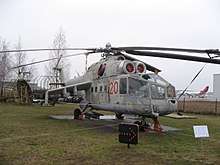 Mi-24A
Mi-24A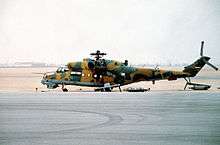 Iraqi Mi-24D captured during the Gulf War
Iraqi Mi-24D captured during the Gulf War Mi-24D cockpit
Mi-24D cockpit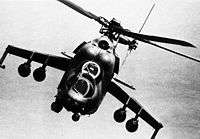 Mi-24V of the Soviet Air Forces
Mi-24V of the Soviet Air Forces Mi-24W(V) of the Polish Air Force
Mi-24W(V) of the Polish Air Force- Mi-24P of the East German Air Force
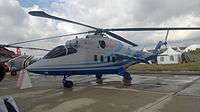 Mi-PSV at MAKS 2015
Mi-PSV at MAKS 2015
References
- "Mil Mi-24 Hind: A Russian Gunship With Attitude".
- Mi-24 Hind Variants
- Taylor, John W.R. (1983). Jane's All the World's Aircraft 1982–83. London: Jane's Publishing Company. ISBN 978-0-7106-0748-5.
- Gordon, Yefim; Komissarov, Dmitry (2001). Mil Mi-24 Hind, Attack Helicopter. Airlife.
- https://tass.com/defense/1085565
- "Russia Gets More Pretty Super Gunships", Strategy page, archived from the original on 2007-02-08.
- Superhind Mk2, ATE Group, archived from the original on March 2, 2008
- Superhind MkIV, ATE Group, archived from the original on March 2, 2008
- Goebel, Greg, "Hind Variants/Soviet Service", FAQs.
- "MAKS 2019: Rostec unveils Mi-24P-1M upgraded combat helicopter". janes.com. 29 August 2019. Archived from the original on 29 August 2019. Retrieved 8 September 2019.
- MIL Mi-35M upgraded combat transport helicopter, Aviamarket.
- The Military Balance 2018.
- http://airrecognition.com/index.php/archive-world-worldwide-news-air-force-aviation-aerospace-air-military-defence-industry/global-defense-security-news/2019-news-aerospace-industry-air-force/april/4985-all-mi-35m-assault-helicopters-equipped-with-vitebsk-onboard-defense-system.html
- Russian planes.
- "Egypt, Algeria to receive President-S countermeasures systems from Russia - defenceWeb".
- "Russia deploys multirole Mi-35M attack helicopter with new EW complex Vitebsk in Syria – Defence Blog".
- "Army 2018 Russian helicopters pitches new Mi-24 upgrade", Jane's.
- "ARMY 2018: Rostec Presents a Modernized Night Hunter Helicopter".
- Flugrevue, November 2015, pp. 54f
- Karnozov, Vladimir. "Russian Military Still Funding High-Speed Rotorcraft". Ain online. Moscow. Retrieved 29 October 2015.
- "AHS – Russia sets unofficial speed record". VTOL. 8 November 2016. Retrieved 10 November 2016.
- Rotorcraft Absolute: Speed over a straight 15/25 km course, Fédération Aéronautique Internationale (FAI), 2013-12-03, search under E-1 Helicopters and "Speed over a straight 15/25 km course", archived from the original on 2013-12-03, retrieved 26 April 2014.
External links
| Wikimedia Commons has media related to Mil Mi-24. |